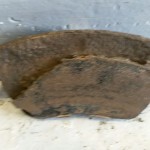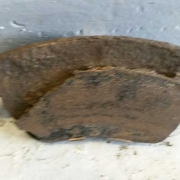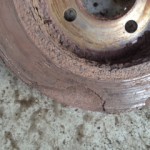Shocking state of front brake pad and disc
 Would you have any idea if you were driving around with brake pads and discs that looked like this???
Would you have any idea if you were driving around with brake pads and discs that looked like this???
The images here show a broken front brake pad and a seriously corroded front brake disc. This is the view from the inside which is very difficult to see without removing the wheels.
We strongly recommend having your brake system checked once a year for general wear and tear and to give you peace of mind.
It is dangerous to wait too long to change your brake pads. We all use our brakes repeatedly over thousands of miles, and the brake pads gradually get worn down which reduces their ability to stop the car.
There is no hard and fast way of telling when to change brake pads as it will depend on the type of car you have, what you use it for and how you drive it.
Brake hoses will be checked when having your vehicle serviced to ensure that they are soft and supple and not cracked and rigid. If cracks are found in the brake hoses, they will need to be replaced. Similarly, the metal brake pipes will also be inspected as they can become corroded, especially in snowy regions where chemicals are used on the roads.
A new disc should be shiny from the inside to the outer edge, and fairly uniform, whilst a disc that needs to be changed could have rough spots or pronounced grooves in it. Discs should always be replaced in pairs to create a consistency when braking.
Don’t be surprised if you have to replace the front pads and discs of your car on account of wear and tear as most of the work is done here to stop the car. Front discs will wear and eventually become too thin and therefore need changing along with the brake pads.
The rear pads and discs are more likely to need replacing due to corrosion as the braking effort is much lower on the rear, especially on a smaller vehicle and may not be enough to clean corrosion from the surface of rear discs, particularly if the vehicle is used only infrequently and for local trips. Corrosion and rusting in the rear discs are one of the main issues that can occur when a car is used rarely as is demonstrated in the photo we have taken recently of a car that is not driven often.
To begin with, light corrosion can be cleaned off under reasonably heavy braking, but if left, this light corrosion gets worse and can lead to surface pitting which eventually weaken the discs.
The vehicle would fail an MOT if the discs were deemed to be so corroded or pitted that they have become ‘seriously weakened’




























